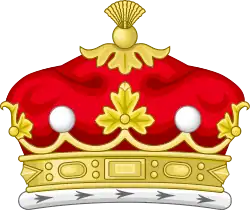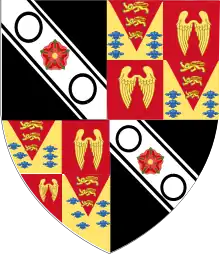Marquess of Hertford
The titles of Earl of Hertford and Marquess of Hertford have been created several times in the peerages of England and Great Britain.
| Marquessate of Hertford | |
|---|---|
  Arms: Sable, on a bend cotised Argent a Rose Gules, between two Annulets of the first (for Conway); quartering Quarterly, 1st and 4th: Or, on a Pile Gules between six Fleurs-de-lys Azure three Lions of England (special grant); 2nd and 3rd: Gules, two Wings conjoined in lure Or (Seymour, arms of Edward Seymour, 1st Duke of Somerset (d.1552)). Crests: 1st: the Bust of a Moor in profile couped at the shoulders proper, and wreathed about the temples Argent and Azure (Conway). 2nd: out of a Ducal Coronet Or, a Phoenix Or, issuing from of flames proper (Seymour). Supporters: On either side a Blackamoor wreathed about the temples Or and Sable, habited in short golden garments and in buskins gold, adorned about their waists with red and green feathers, each holding in his exterior hand a Shield Azure, garnished Or, the dexter charged with a Sun-in-Splendour gold, and the sinister with a Crescent Argent.
[1] | |
| Creation date | 5 July 1793 |
| Creation | Second |
| Monarch | George III |
| Peerage | Peerage of Great Britain |
| First holder | Francis Seymour-Conway, 1st Marquess of Hertford |
| Present holder | Henry Seymour, 9th Marquess of Hertford |
| Heir apparent | William Seymour, Earl of Yarmouth |
| Remainder to | The 1st Marquess's heirs male of the body lawfully begotten |
| Subsidiary titles | Earl of Hertford Earl of Yarmouth Viscount Beauchamp Baron Conway Baron Conway and Killultagh |
| Status | Extant |
| Seat(s) | Ragley Hall |
| Motto | FIDE ET AMORE (By faith and love) |
| For the 1st Creation see the Dukedom of Somerset | |
The third Earldom of Hertford was created in 1559 for Edward Seymour, who was simultaneously created Baron Beauchamp of Hache. His grandson William Seymour was subsequently created Marquess of Hertford and restored to the title of Duke of Somerset; the Marquessate became extinct in 1675 and the other three titles in 1750.
The present Marquessate was created in 1793. Lord Hertford holds the subsidiary titles of Earl of Yarmouth (Peerage of Great Britain, 1793), Earl of Hertford (Peerage of Great Britain, 1750), Viscount Beauchamp (Peerage of Great Britain, 1750), Baron Conway, of Ragley in the County of Warwick (Peerage of England, 1703), and Baron Conway of Killultagh, of Killultagh in the County of Antrim (Peerage of Ireland, 1712). Lord Hertford's heir uses the style Earl of Yarmouth.
The Marquesses of Hertford are members of the Seymour family headed by the Duke of Somerset. Francis Seymour (1679–1732) was the fourth son of Sir Edward Seymour of Berry Pomeroy, 4th Baronet, a descendant of Edward Seymour, 1st Duke of Somerset (Sir Edward's grandson Sir Edward Seymour, 6th Baronet, of Berry Pomeroy succeeded as 8th Duke of Somerset in 1750). Upon the death of his elder brother, Francis succeeded to the estates of his relative Edward Conway, 1st Earl of Conway. In 1703 he was created Baron Conway in the Peerage of England and assumed the additional surname of Conway. In 1712 he was created Baron Conway of Killultagh in the Peerage of Ireland. In 1750 his son Francis Seymour-Conway, 2nd Baron Conway, was created Viscount Beauchamp and Earl of Hertford.[2] These were revivals of titles previously held by the Dukes of Somerset, which had become extinct the same year on the death of Seymour-Conway's kinsman Algernon Seymour, 7th Duke of Somerset. In 1793 he was further honoured when he was made Earl of Yarmouth and Marquess of Hertford.[3] The latter title had also previously been held by the Dukes of Somerset, but had become extinct in 1675 (see below).
The family seat is Ragley Hall, near Alcester, Warwickshire.
Earls of Hertford, First creation (1138)
- Richard Fitz Gilbert de Clare (d. 1136), traditionally but erroneously called Earl of Hertford
- Gilbert de Clare, 1st Earl of Hertford (d. 1153)
- Roger de Clare, 2nd Earl of Hertford (d. 1173)
- Richard de Clare, 3rd Earl of Hertford (d. 1217)
- Gilbert de Clare, 4th Earl of Hertford (d. 1230) became Earl of Gloucester in 1218
- For further Earls, see Earl of Gloucester.
Earls of Hertford, Second creation (1537)
- Edward Seymour, 1st Duke of Somerset, 1st Earl of Hertford (1506–1552), forfeit 1552
Earls of Hertford, Third creation (1559)
- Edward Seymour, 1st Earl of Hertford (1539–1621)
- William Seymour, 2nd Earl of Hertford (1587–1660) (became Marquess of Hertford in 1641)
Marquesses of Hertford, First creation (1641)
- William Seymour, 2nd Duke of Somerset, 1st Marquess of Hertford, 2nd Earl of Hertford (1587–1660) (restored to the Dukedom of Somerset in 1660)
- William Seymour, 3rd Duke of Somerset, 2nd Marquess of Hertford, 3rd Earl of Hertford (1651–1671)
- John Seymour, 4th Duke of Somerset, 3rd Marquess of Hertford, 4th Earl of Hertford (d. 1675) (Marquessate extinct 1675)
Earls of Hertford, Third creation (1559; Reverted)
- Francis Seymour, 5th Duke of Somerset, 5th Earl of Hertford (1658–1678)
- Charles Seymour, 6th Duke of Somerset, 6th Earl of Hertford (1662–1748)
- Algernon Seymour, 7th Duke of Somerset, 7th Earl of Hertford (1684–1750) (Earldom extinct on his death in 1750)
Barons Conway, Second creation (1703)
- Francis Seymour-Conway, 1st Baron Conway (1679–1732)
- Francis Seymour-Conway, 2nd Baron Conway, (1718–1794) (created Earl of Hertford in 1750 and Marquess of Hertford in 1793)
Earls of Hertford, Fourth creation (1750)
- Francis Seymour-Conway, 1st Earl of Hertford, 1st Viscount Beauchamp, 2nd Baron Conway (1718–1794) (created Marquess of Hertford and Earl of Yarmouth in 1793)
Marquesses of Hertford, Second creation (1793)
- Francis Seymour-Conway, 1st Marquess of Hertford (1718–1794)
- Francis Ingram-Seymour-Conway, 2nd Marquess of Hertford (1743–1822)
- Francis Charles Seymour-Conway, 3rd Marquess of Hertford (1777–1842)
- Richard Seymour-Conway, 4th Marquess of Hertford (1800–1870)
- Francis Hugh George Seymour, 5th Marquess of Hertford (1812–1884)
- Hugh de Grey Seymour, 6th Marquess of Hertford (1843–1912)
- George Francis Alexander Seymour, 7th Marquess of Hertford (1871–1940)
- Hugh Edward Conway Seymour, 8th Marquess of Hertford (1930–1997)
- Henry Jocelyn Seymour, 9th Marquess of Hertford (b. 1958)
The heir apparent is the present holder's eldest son, William Francis Seymour, Earl of Yarmouth (b. 1993)
Line of Succession

 Francis Seymour-Conway, 1st Baron Conway, 1st Baron Conway of Killultagh (1679–1731/2)
Francis Seymour-Conway, 1st Baron Conway, 1st Baron Conway of Killultagh (1679–1731/2)
 Francis Seymour-Conway, 1st Marquess of Hertford (1718–1794)
Francis Seymour-Conway, 1st Marquess of Hertford (1718–1794)
 Francis Seymour-Ingram, 2nd Marquess of Hertford (1743–1822)
Francis Seymour-Ingram, 2nd Marquess of Hertford (1743–1822)
 Francis Charles Seymour-Conway, 3rd Marquess of Hertford (1777–1842)
Francis Charles Seymour-Conway, 3rd Marquess of Hertford (1777–1842)
 Richard Seymour-Conway, 4th Marquess of Hertford (1800–1870)
Richard Seymour-Conway, 4th Marquess of Hertford (1800–1870)- Lord Henry Seymour-Conway (1805–1859)
- Admiral Lord Hugh Seymour (1759–1801)
- Admiral Sir George Francis Seymour (1787–1870)
 Sir Francis George Hugh Seymour, 5th Marquess of Hertford (1812–1884)
Sir Francis George Hugh Seymour, 5th Marquess of Hertford (1812–1884)
 Hugh de Grey Seymour, 6th Marquess of Hertford (1843–1912)
Hugh de Grey Seymour, 6th Marquess of Hertford (1843–1912)
 George Francis Alexander Seymour, 7th Marquess of Hertford (1871–1940)
George Francis Alexander Seymour, 7th Marquess of Hertford (1871–1940)- Brigadier-General Lord Henry Charles Seymour (1878–1939)
 Hugh Edward Conway Seymour, 8th Marquess of Hertford (1930–1997)
Hugh Edward Conway Seymour, 8th Marquess of Hertford (1930–1997)
 Henry Jocelyn Seymour, 9th Marquess of Hertford (b. 1958)
Henry Jocelyn Seymour, 9th Marquess of Hertford (b. 1958)
- (1). William Francis Seymour, Earl of Yarmouth (b. 1993)
- (2). Clement Andrew Seymour, Viscount Beauchamp (b. 2019)
- (3). Lord Edward George Seymour (b. 1995)
- (1). William Francis Seymour, Earl of Yarmouth (b. 1993)
- Lord George Frederick Seymour (1881-1940)
- Paul de Grey Horatio Seymour (1911-1942)
- (4). Andrew Conway Paul Seymour (b. 1939)
- George Victor Seymour (1912-1953)
- (5). Nicholas George Mark Seymour (b. 1953)
- Paul de Grey Horatio Seymour (1911-1942)
- Revd. Lord Victor Alexander Seymour (1859-1935)
- Conway Hugh Seymour (1886-1931)
- Adrian John Conway Seymour (1918-2020)
- Francis Hugh Seymour (1922-2014)
- (6). William Thomas Seymour (b. 1955)
- William John Seymour (1900-1967)
- Conway William Hugh Seymour (1934-2015)
- (7). Conrad Ronald Hugh Seymour (b. 1962)
- Conway William Hugh Seymour (1934-2015)
- Conway Hugh Seymour (1886-1931)
- Hugh Henry John Seymour (1790-1821)
- Hugh Horatio Seymour (1821-1892)
- Hugh Francis Seymour (1855-1930)
- Sir Horace James Seymour (1885-1978)
- Hugh Francis Seymour (1926-2010)
- (8). Hugh James Seymour (b. 1956)
- (9). Hugo Frederick James Seymour (b. 1988)
- (10). Rupert Alexander Erskine Seymour (b. 1992)
- (11). Felix Horatio Hindmarch Seymour (b. 2000)
- (12). Otto Storm Hindmarch Seymour (b. 2003)
- (8). Hugh James Seymour (b. 1956)
- Hugh Francis Seymour (1926-2010)
- Sir Horace James Seymour (1885-1978)
- Hugh Francis Seymour (1855-1930)
- Hugh Horatio Seymour (1821-1892)
- Admiral Sir George Francis Seymour (1787–1870)
References
- Debrett's Peerage, 1968, p.1036
- "No. 8975". The London Gazette. 31 July 1750. p. 2.
- "No. 13541". The London Gazette. 29 June 1793. p. 543.
Further reading
- 'Earls and Marquesses of Hertford' on Leigh Rayment's Peerage Page. Retrieved 15 December 2009.